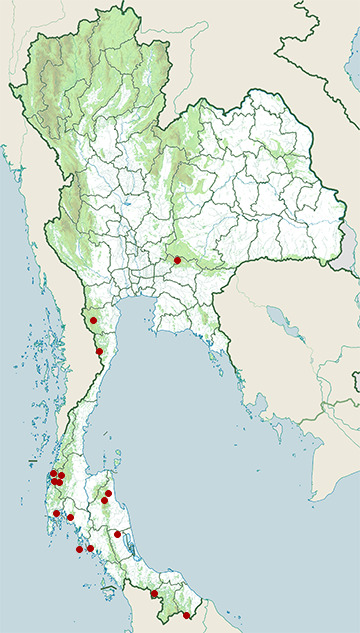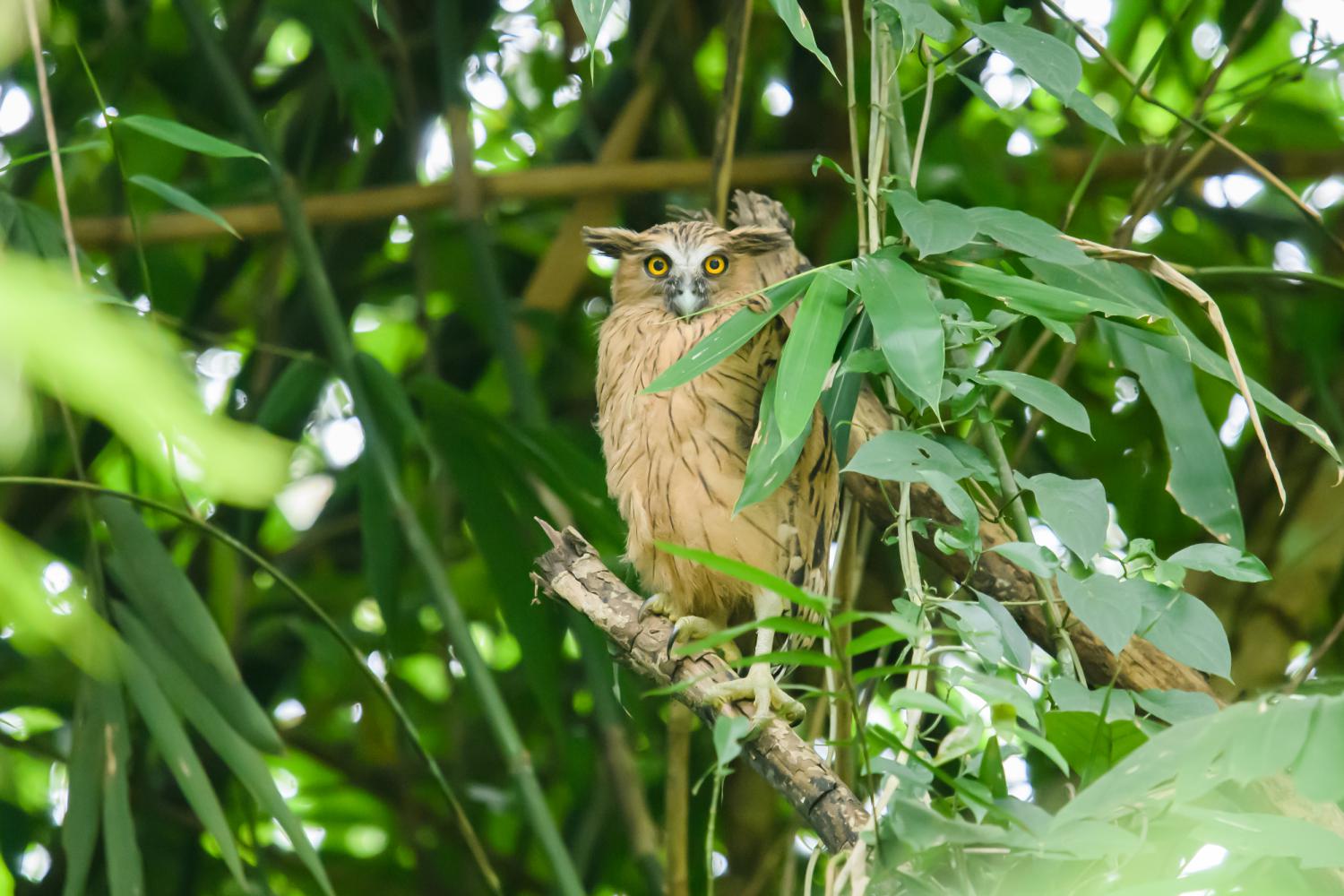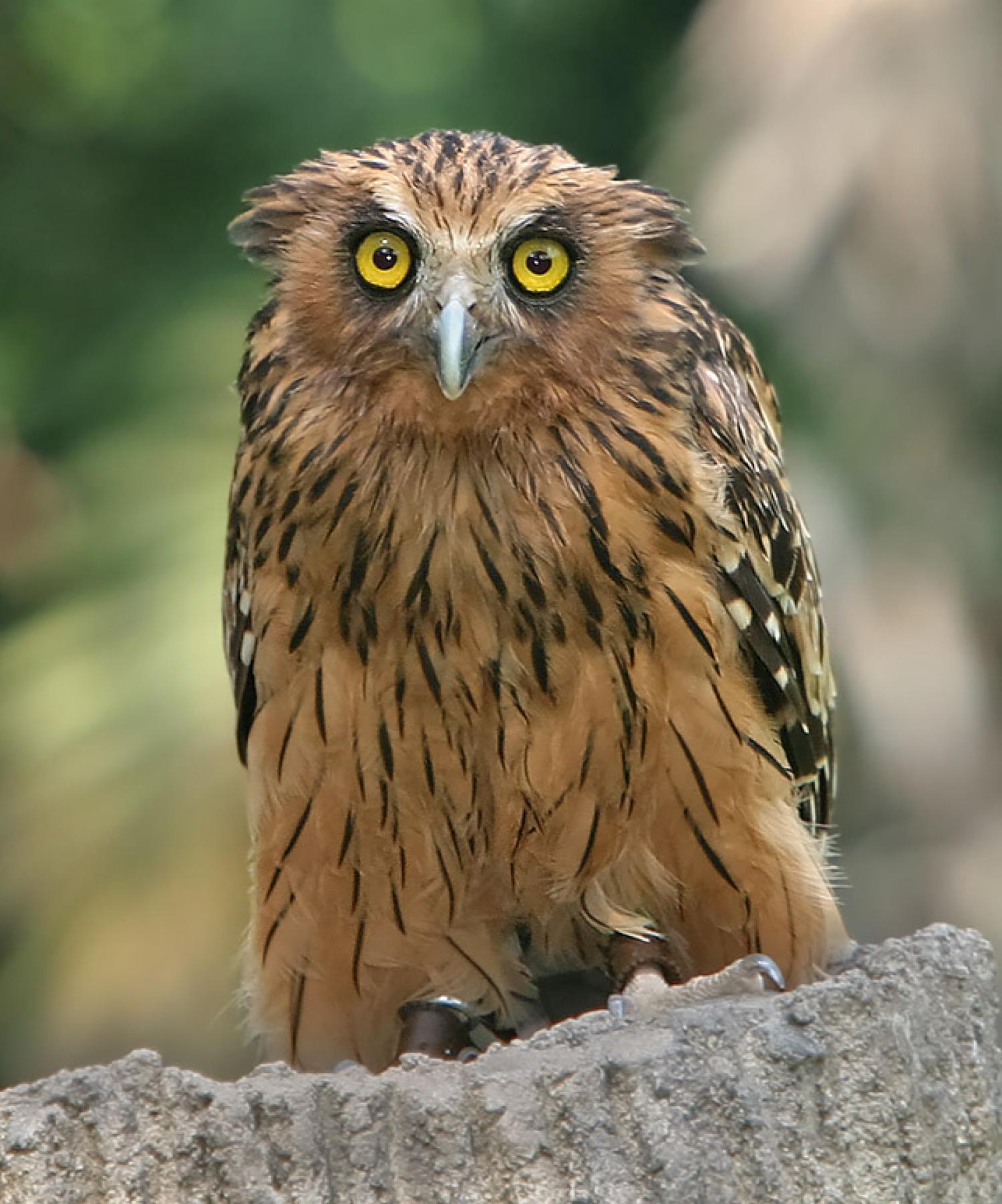Species of Thailand
Buffy fish owl
Ketupa ketupu
Thomas Horsfield, 1821
In Thai: นกทึดทือพันธุ์มลายู
The buffy fish owl (Ketupa ketupu), also known as the Malay fish owl, is a fish owl in the family Strigidae. It is native to Southeast Asia and lives foremost in tropical forests and wetlands. Due to its wide distribution and assumed stable population, it is listed as Least Concern on the IUCN Red List since 2004.
Taxonomy
Strix ketupu was the scientific name proposed by Thomas Horsfield in 1821 for a buffy fish owl collected in Java.
Ketupa was proposed as generic name by René-Primevère Lesson in 1831 for fish owl species from Java and India. In the 19th and 20th centuries, several zoological specimens of buffy fish owls were described:
- Ketupa minor by Johann Büttikofer in 1896 were two small fish owls collected on Nias island with a wing chord of 29.5 - 30 cm, a tail of 14 - 14.5 cm and a short bill of 3.5 cm.
- Bubo ketupu aagaardi by Oscar Neumann in 1935 was a pale fish owl specimen from Bangnara in Thailand with a wing chord of 31.5 - 34.5 cm.
- Bubo ketupu pageli also by Neumann in 1935 was a reddish fish owl from the mountains of northeastern Borneo with a wing chord of 31 - 33 cm.
All four are recognised today as Ketupa ketupu subspecies:
- K. k. aagaardi as occurring from West Bengal, Assam to southern Thailand and Vietnam
- K. k. ketupu as occurring from the Malay Peninsula to Riau Archipelago, Sumatra, Belitung, Java, Bali and much of Borneo
- K. k. pageli as occurring in northern Borneo
- K. k. minor as endemic to Nias island.
It has been suggested to merge the genus Ketupa into the genus Bubo based on their close relation in mitochondrial DNA and similarities in general appearance.
Results of a phylogenetic analysis of nine horned owl species indicate that Ketupa species form a monophyletic group.
Description
The buffy fish owl is buff brown with darker tawny brown feathers on the back. Its face is paler and it has light brown eyebrows. With an adult size of 40 to 48 cm and a weight of 1028 to 2100 g, it is the smallest fish owl species.
Like all fish owls, the buffy fish owl has prominent ear tufts on the sides of the head. Its wing feathers and tail are broadly barred yellowish and dark brown. The wings are distinctly rounded in shape. The underparts are a yellowish brown, rich buff or fulvous with broad blackish shaft stripes. Its long legs are not feathered.
The fish owls have large, powerful, and curved talons and a longitudinal sharp keel underneath the middle claw with all having sharp cutting edges that are very much like those of eagle owls. Unlike fish-eating diurnal raptors, they do not submerge any part of their body while hunting, preferring only to put their feet into the water, although fish owls wade into the shallows. The feathers of fish owls are not soft to the touch and lack the comb and hair-like fringes to the primaries, which allow other owls to fly silently in order to ambush their prey. Due to the lack of these feather-specializations, fish owl wing beats make sounds. The lack of a deep facial disc in fish owls is another indication of the unimportance of sound relative to vision in these owls, as facial disc depth (as well as inner ear size) are directly related to how important sound is to an owl's hunting behavior. Also different from most any other kind of owl, the bill is placed on the face between the eyes rather than below it, which is said to impart this fish owl with a "remarkably morose and sinister expression". Similar adaptations, such as unwillingness to submerge beyond their legs and lack of sound-muffling feathers are also seen in the African fishing owls, which do not seem to be directly related. Due to their neat replacement of each other in range, at one time the tawny and buffy fish owls were considered the same species but there are a number of physical, anatomical, habitat, and behavioral distinctions between them.
Distribution and habitat
The buffy fish owl is distributed from Bangladesh, Myanmar, Thailand, Malaysia and Singapore to Cambodia, Laos, Vietnam, and the Sunda Islands. On Cocos (Keeling) Island, it is non-breeding. It inhabits tropical forests and freshwater wetlands near rivers, lakes and aquaculture sites up to an elevation of 1600 m. It also lives in plantations, and rural and urban gardens.
Behaviour and ecology
A range of vocalizations has been attributed to the buffy fish owl. Among those recorded are included hissing sounds and a rattling kutook, repeated rapidly about seven times. Also recorded has been a ringing, loud pof-pof-pof and a high, hawk-like hie-e-e-e-e-keek series of notes. The buffy fish owl is rather noisy before breeding, and pairs may engage in bouts of duetting for several minutes at a time. During the daytime, it shelters often singly in densely foliaged trees.
Diet
The buffy fish owl feeds foremost on fish, crabs, frogs, small reptiles and birds. It also forages on carrion. Stomach content found in Javan buffy fish owls included insects, winged ants and winged termites, goldfish (Carassius auratus), gold-ringed cat snake (Boiga dendrophila), immature false gharials (Tomistoma schlegelii), red junglefowl (Gallus gallus), black rat (Rattus rattus), and fruit bats.
It has been recorded consuming remains of a crocodile and a Sunda stink badger (Mydaus javanensis). The buffy fish owl does not produce firm pellets as do most owls. Instead, bones, and frog and insect remains are ejected in pieces and fall to the ground below the roost. Prey remains have only been found within the nest, never around or below the nest as is commonly recorded in other owls. The buffy fish owl hunts mainly from the bank, swooping down much in the manner of a fish eagle but never getting its feathers wet. It also walks into shallow streams and brooks, additionally snatching food in such locations.
Reproduction
Eggs of buffy fish owls have mainly been found in February through April in western Java, less commonly into May, and in the Malay Peninsula also in September through January. The buffy fish owl frequently nests on top of a large fern (Asplenium nidus), but nests have also been recorded in the fork of a tall bough covered in ferns and moss, on orchid beds and in tree holes. More rarely, rocky sites have been used as nesting sites, even behind waterfalls. The nest is usually merely a scrape into the surface of a fern with no structure or lining, as owls do not build nests. Abandoned bird nests built by other species have been used, including those of brahminy kite (Haliastur indus). Only one egg per breeding season has ever been recorded in a buffy fish owl nest, giving them the smallest clutch size of any owl alongside the spot-bellied eagle owl (B. nipalensis) and the barred eagle owl (B. sumatranus), which also have only ever been recorded with a single-egg clutch. The egg is round, oval and dull white. The average dimensions of eggs in western Java was 57.4 x 47 mm. Incubation of the eggs lasts 28 to 29 days and fledging occurs after six weeks. This species is generally faring well for a large raptorial bird and has been inadvertently aided by commercial fisheries and ornamental ponds, which they visit by night to hunt. Sometimes, they incur persecution from owners of such ponds for taking stock.
Threats
During a seizure in 2008 in a storage facility in Johor, 14 frozen buffy fish owls were discovered that were supposed to be illegally exported to China.
In Jakarta, buffy fish owls were offered for sale in three bird markets in 2010 and 2012.
In 2015, 323 buffy fish owls were offered for sale through online raptor trading groups.
Buffy fish owls were also traded at wildlife markets in Bandung, Garut, Surabaya, and Denpasar.
Conservation
In Malaysia, owl species are protected by the Protection of Wild Life Act 1972 and listed by the Convention on International Trade in Endangered Species on Appendix II. Violation of this act is a punishable offense and is penalized with a fine of 3, 000 Malaysian ringgit or two years in jail or both.
This article uses material from Wikipedia released under the Creative Commons Attribution-Share-Alike Licence 3.0. Eventual photos shown in this page may or may not be from Wikipedia, please see the license details for photos in photo by-lines.
Category / Seasonal Status
BCST Category: Recorded in an apparently wild state within the last 50 years
BCST Seasonal status: Resident or presumed resident
Scientific classification
- Kingdom
- Animalia
- Phylum
- Chordata
- Class
- Aves
- Order
- Strigiformes
- Family
- Strigidae
- Genus
- Ketupa
- Species
- Ketupa ketupu
Common names
- Thai: นกทึดทือพันธุ์มลายู
Subspecies
Bubo ketupu aagaardi, Oscar Rudolph Neumann, 1935
Range: Found in southern Burma to peninsular Thailand and Vietnam. This race is similar to the nominate but is much paler, especially on the underparts. The wing chord is 315 to 354 mm, other than that it is of the same size as the nominate in linear dimensions.
Bubo ketupu ketupu, Thomas Horsfield, 1821
Range: Found in the Malay Peninsula, Riau Archipelago, Sumatra, Borneo, Belitung, Java, Bali and much of Borneo. This race matches the description above. It is the only well-studied race and is seemingly the largest, slightly more so than aagaardi and considerably more so than the other two island races. The wing chord is 335 to 390 mm, the tail is 160 to 181 mm, the tarsus is 70 to 80 mm and the bill is 40 to 42 mm.
Bubo ketupu minor, Johann Büttikofer, 1896
Range: Found only on the island of Nias. This race is notably for its very small size. The wing chord is 295 to 300 mm.
Bubo ketupu pageli, Oscar Rudolph Neumann, 1936
Range: Endemic to Sarawak on the east coast of northern Borneo. This race is similar to the noinate but is far more reddish in color, with some birds being a brick-red color. The wing chord is 310 to 330 mm.
Synonyms
- Bubo ketupu, Thomas Horsfield (1821)
Photos
Please help us review the bird photos if wrong ones are used. We can be reached via our contact us page.
Range Map

- Ao Phang-Nga National Park
- Hala-Bala Wildlife Sanctuary
- Hat Chao Mai National Park
- Kaeng Krachan National Park
- Khao Luang National Park
- Khao Nan National Park
- Khao Sok National Park
- Khao Yai National Park
- Khlong Saeng Wildlife Sanctuary
- Khuan Khanun District, Phatthalung
- Khura Buri District, Phang Nga
- Ko Lanta National Park
- Kui Buri National Park
- Mueang Krabi District, Krabi
- San Kala Khiri National Park
- Sri Phang Nga National Park



